On the first matchday of Group C of the third World Cup day, Argentina and Saudi Arabia met at the Lusail Iconic Stadium. Argentina went into this match as clear favourites and wanted to convince with a good performance in the first match.
The Argentines can currently point to an impressive series of 36 games without defeat. Lionel Scaloni’s team last lost 0-2 to Brazil at the Copa America in 2019. After that, Argentina won the Copa America in 2021 and went through the South American World Cup qualifiers without defeat. Their record in their last five matches is five wins and 19-0 goals.
Saudi Arabia, who are making their fifth World Cup appearance, lost their last test match against Croatia 1-0, while French coach Hervé Renard’s team finished the Asian World Cup qualifying campaign with just one defeat.
A united and aggressive defensive performance and an ice-cold exploitation of chances in the second half enabled Saudi Arabia to pull off the surprise and defeat their opponents, who were considered one of the favourites for the title, 2-1.
In this tactical analysis article, we will focus on Saudi Arabia’s defence and tactics that made the victory possible, but we will also look at Argentina’s mistakes. First, we will start the analysis by introducing the two lineups.
Lineups
Scaloni sent his team onto the pitch in a 4-4-2 system. Aston Villa keeper Emiliano Martinez played in goal and the back four in front of him were Nahuel Molina, Cristian Romero, Nicolas Otamendi and Nicolas Tagliafico. The centre of the Argentine midfield consisted of Rodrigo de Paul and Leandro Paredes. Angel Di Maria and Alejandro Gomez started on the two flanks and Lautaro Martinez and the captain and top star Lionel Messi, currently of PSG and formerly of Barcelona, played up front.
Renard set up his team in an official 4-4-2 system, which was very variable on the field. Mohammed Al-Owais played in goal and the defensive back four consisted of Yasser Al-Shahrani, Ali Al-Bulaihi, Hassan Tambakti and Saud Abdulhamid. The nominal midfield four formed Salem Al-Dawsari, Mohamed Kanno, Abdulellah Al-Malki and Firas Al-Buraikan. Saleh Al-Shehri and Salman Al-Faraj, who was substituted in the first half due to injury, started in the front two.
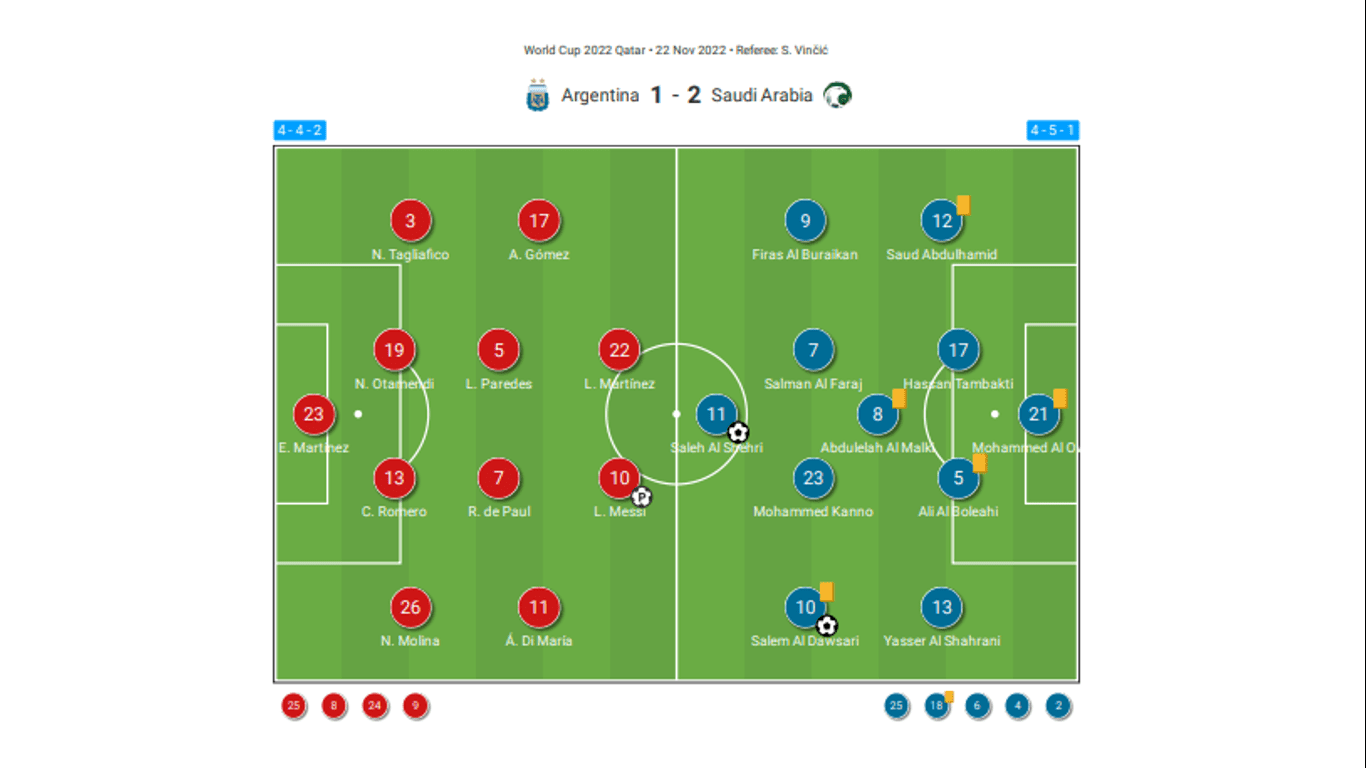
Saudi Arabia’s defensive performance
Saudi Arabia were able to keep the strong Argentinian attack under control, especially from the second half onwards, with a cohesive and aggressive defensive performance. In doing so, they were flexible between man and space orientation in the defensive formation time and again.
In general, the defensive chain stood very compact and only offered the opponent spaces on the two outer lanes. Time and again, they established a close link with the defending midfielders in front by pushing up the last line of defence.
They also supported each other and sometimes doubled on opponents such as Messi. The players communicated well with each other and were able to coordinate accordingly.
As a result, the centre-backs were sometimes able to move out with their opponents when they were coming forward, in order to be able to interfere with the reception. Despite one defender moving out, the defence was still well organised. The strikers helped in the pressing situation from the top.
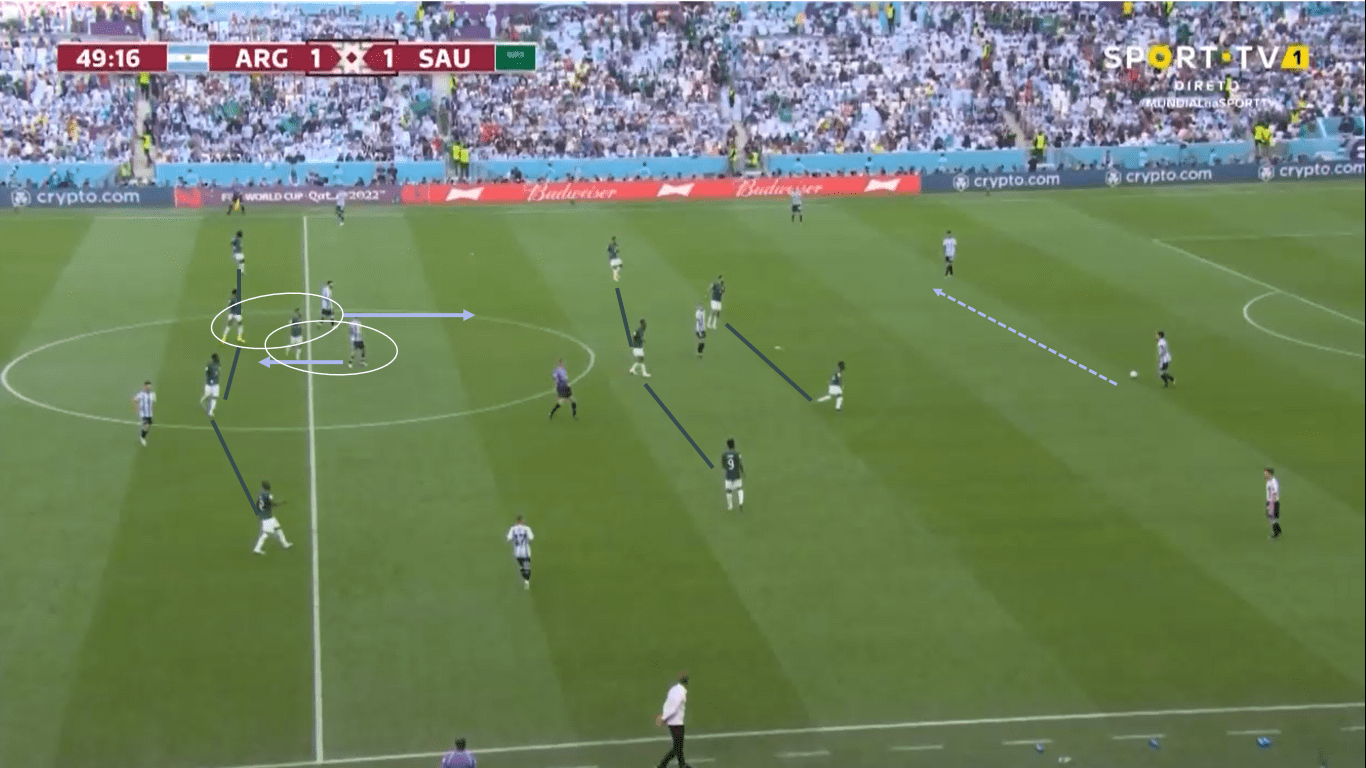
In this picture, you can see the situation just mentioned. In the second half, Saudi Arabia played a 4-1-3-2 system against the ball. Their main focus is on keeping the centre compact with four strong central lines.
Argentina are in the build-up phase here and are looking for solutions. The ball comes to the right centre-back, Romero. Due to the flat outside defenders of the Argentines, the outer players of the second attacking line are not pulled to the outside and can continue to hold the centre.
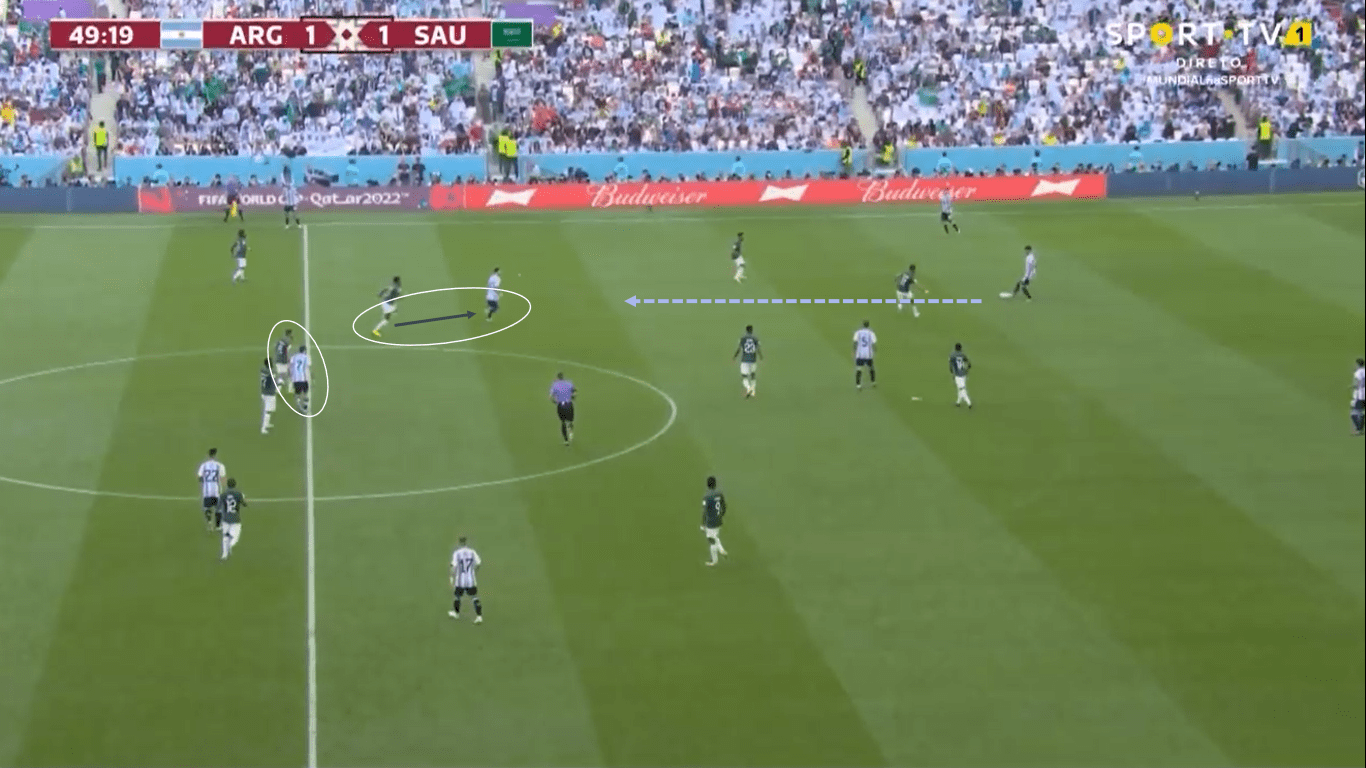
The ball is played by Romero to the oncoming Messi. In the process, Saudi Arabia’s first two attacking lines are outplayed for the time being. Comparing the defence in this picture with the previous one, a swap of positions is noticeable.
The nominal CM stays with his opposite number, offering a deep run. Saudi Arabia’s left centre-back chases Messi, who moves into open space.
That describes the mix between man and space coverage quite well. Saudi Arabia’s front two lines are more in space coverage, attacking more the passes played. On the last line of defence, Saudi Arabia goes into man-marking.
This keeps the centre compact and the open spaces for the Argentines are mostly on the wing positions, which will be discussed in more detail in the next chapter.
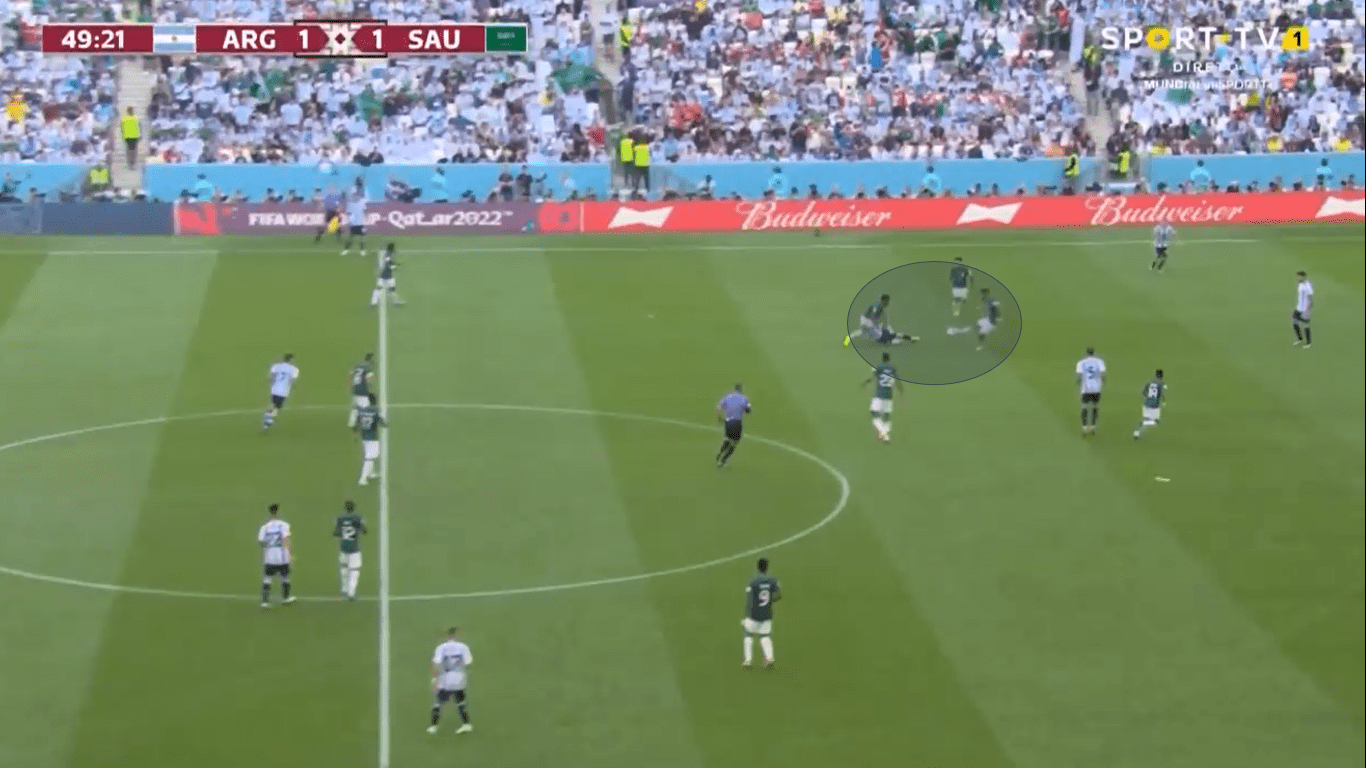
It was just described that Romero’s first two attacking lines were passed a ball. It was important to say that this was only for the time being. As soon as Messi gets the ball, he immediately gets pressure from above from two Saudi Arabia players.
Even though this situation was judged as a foul, it describes well the aggressive and compact team defensive behaviour of the Saudi Arabians. They helped each other again and again, especially against technically and playfully superior players.
In addition to a compact centre, the focus was also on not letting the players who were playing in turn up. By leaving the wing areas uncovered, it could have been quite dangerous here.
If the left centre-back does not move out in the situation described, Messi can open up undisturbed. He would then have the entire pitch in front of him and Argentina would already have played through five players. After turning up, Messi could advance the ball and would have four opportunities to play on the last line with plenty of space on the outer lanes.
Even though such situations have ended positively here and often in the game in general, defending like this also brings a certain amount of risk. Saudi Arabia were nevertheless able to keep these game situations well under control and so were the waves of attacks from the Argentines.
Argentina’s mistakes and chances
Argentina could well have won the game because of the number of chances they had. In the following, we take a closer look at the opportunities that Argentina could have made better use of. We will also point out possible mistakes made by the Argentines that contributed to the defeat.
Saudi Arabia had control of the centre for almost the entire game. Argentina played more of a 4-2-4 system in the build-up play going forward, with some of the central midfielders pushing with them on the last line. This made it difficult for the South Americans to bridge the opponent’s midfield with combination play.
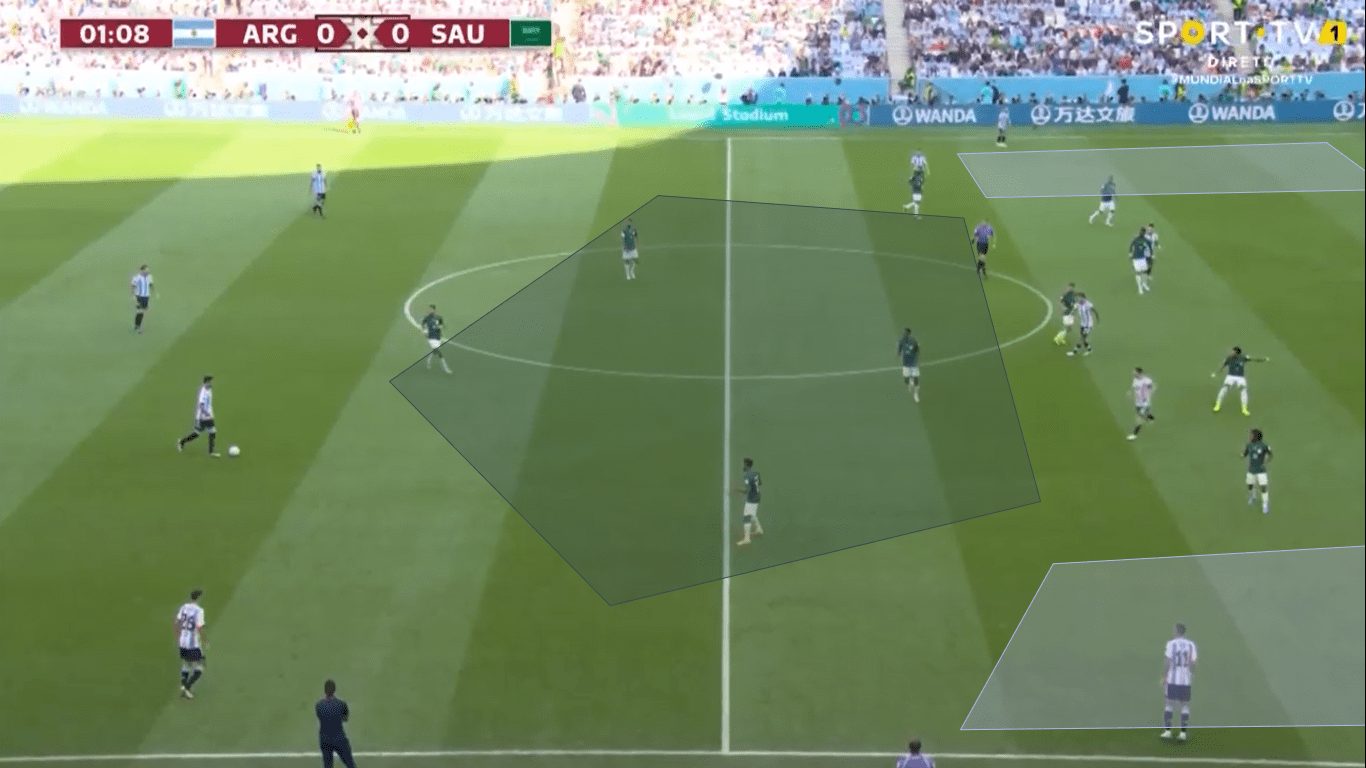
Already in the first minutes of the match, one finds several examples of the described problem. You can see in the picture that the Argentines are playing in the build-up with the back four in defence. In the attacking area are all the other six field players.
Since the two central midfielders have also joined the last line, Saudi Arabia have multiple superior numbers in the centre. This means that there is no connection between the defence and the forward line.
In this situation, it would have been better for the Argentines to occupy the midfield to be able to pull apart the opponent’s already compact defence. Pushing the two CMs up makes it easier for Saudi Arabia to defend, as they can keep the spaces tight and cover several players at the same time.
Another possible resolution for this situation would be to shift play to the outside lanes, where there would be space for deep runs. These spaces are created because Saudi Arabia are very compact with their back four and are keen to close down the centre.
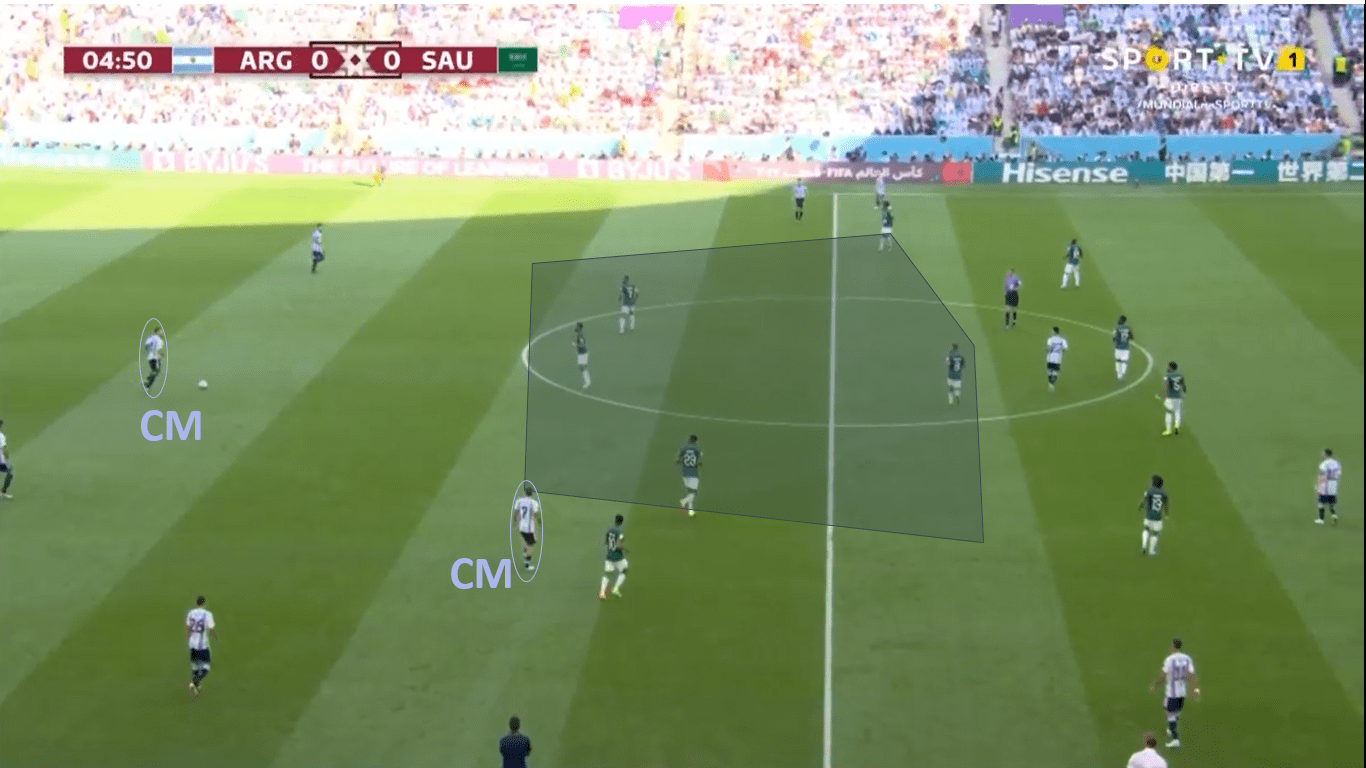
Another problem arose when the two CMs did not push on the last line but stood too deep in the build-up. Here you can see well that one CM drops between the centre-backs. The other CM, however, is not in the centre but towards the right wing.
This gives Saudi Arabia complete control over the centre of midfield again. Likewise, there are again spaces on both flanks because the defensive chain is very compact.
With a player between the Saudi Arabian lines, they could have quickly played over the opponent’s front pressing line from Argentina’s point of view. However, they made it easier for their opponents to defend by having either too many or too few players on the last line.
Argentina often became dangerous through high or low passes, where the timing between the players often caused problems. This also led to three offside goals, which were taken back by the VAR.
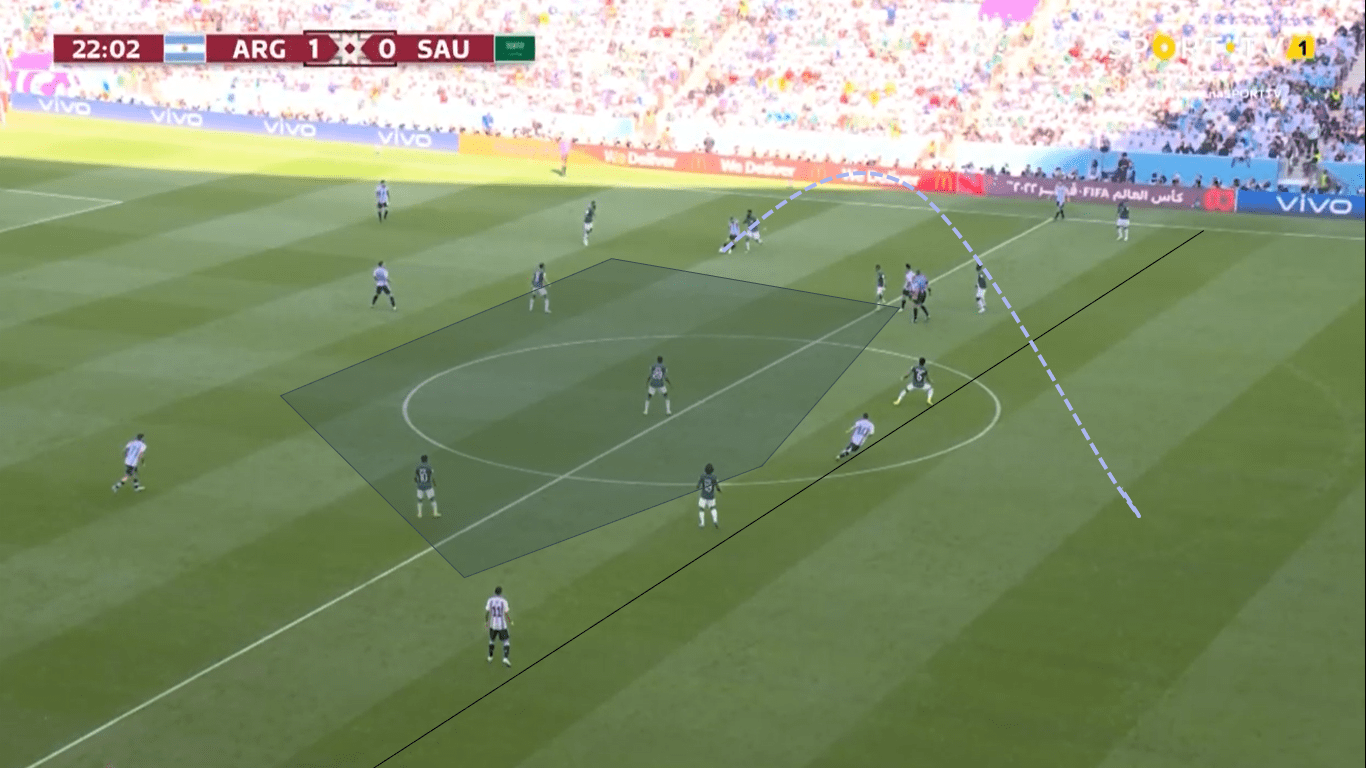
The picture shows the situation shortly before one of the offside goals. Again, you can see that the opponent has more players in the centre of the field. In order to keep the spaces between the rows narrow, the opposing defence stands high.
This creates large spaces behind the defence into which the attackers can run. In the given situation, the ball is played to Messi as a striker, but could also have been played diagonally to the other side.
Since the Argentines had little to no occupation of the centre, there were hardly any other game-building situations than this. This deprived them of the opportunity to play through the opponent’s block with their good combination play.
So the players with the ball on their feet in the build-up play had one option, to play around the block and thereby slow down the game. Or the other option, as in this case, a long, steep pass behind the advanced defensive line. This affected their own build-up play in terms of creativity as well as flexibility.
Saudi Arabia’s midfield pressing
After the half-time break, a clear positive upswing could be seen in the Saudi Arabian national team. They were able to win a lot of balls through strong midfield pressing and, above all, keep the Argentines away from their own goal.
An example of such a pressing situation came shortly after the break. In contrast to the first half, the Saudi Arabian national team was not only concerned with keeping the spaces and the centre tight but took a higher risk in pressing.
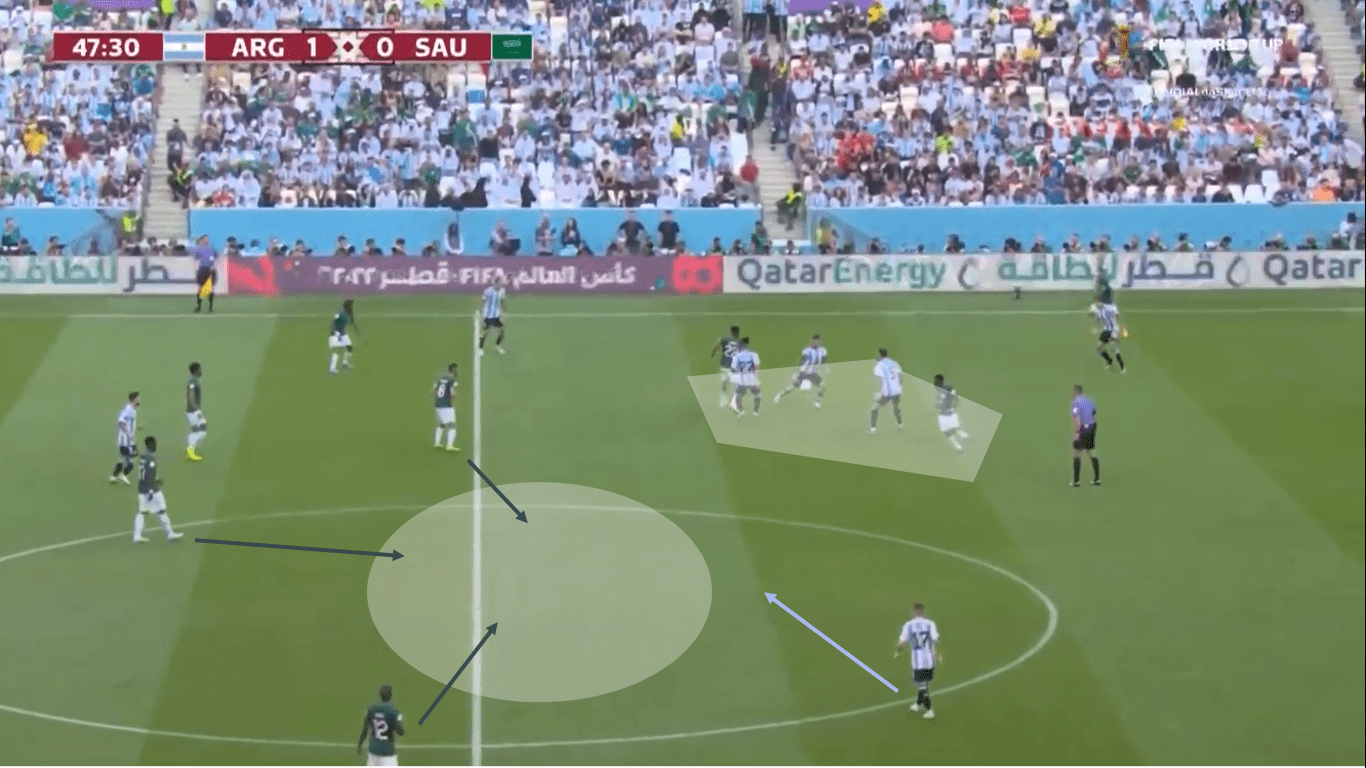
The circle shown describes the space into which the ball is likely to enter. The Saudi Arabian players are generally better positioned than the Argentine players to get the second ball. You can also see that the game is again kept very compact.
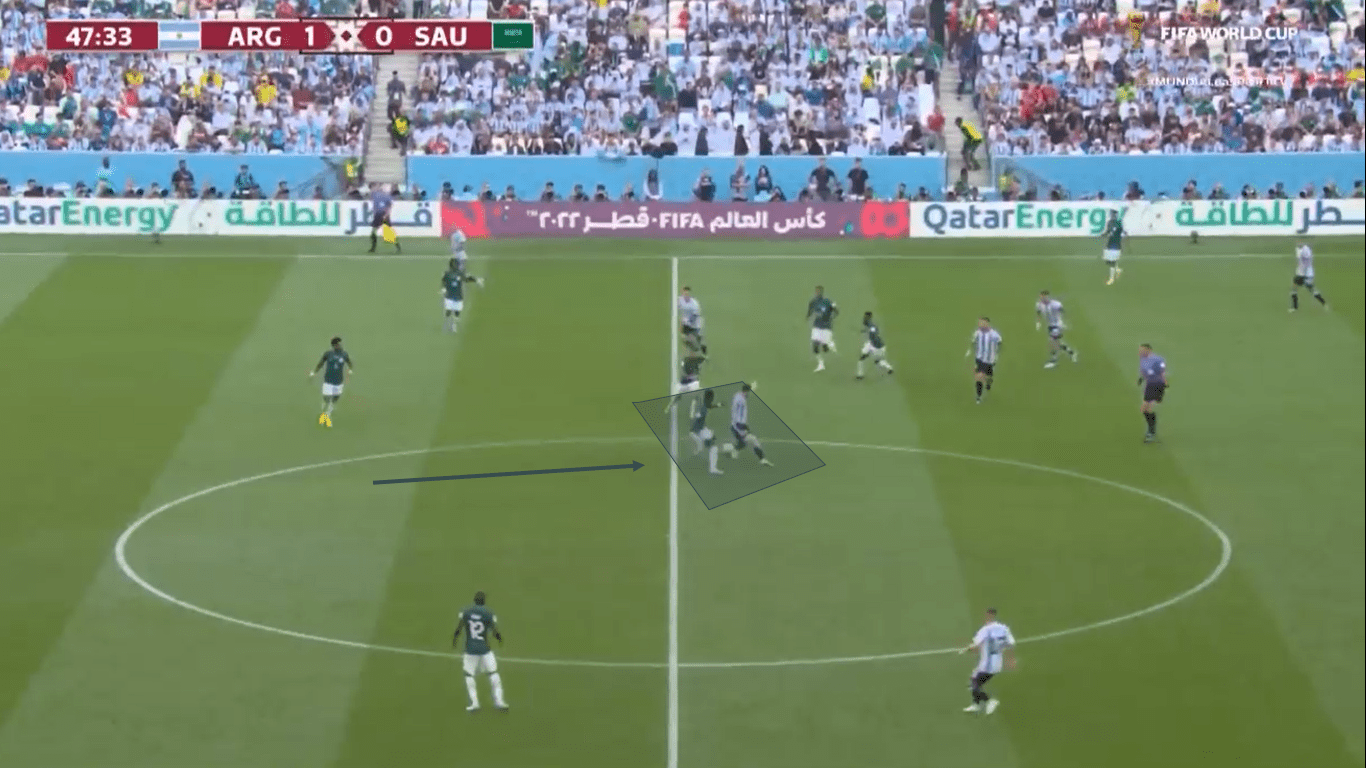
In the next picture you can see that despite the better positioning of the Saudi Arabian players, Messi gets to the ball first. However, he again does not have time to turn and is directly put under pressure by two players.
This midfield pressing allows Saudi Arabia to win the ball in the centre of the midfield. Meanwhile, Argentina was moving forward and the defensive chain is wide open.
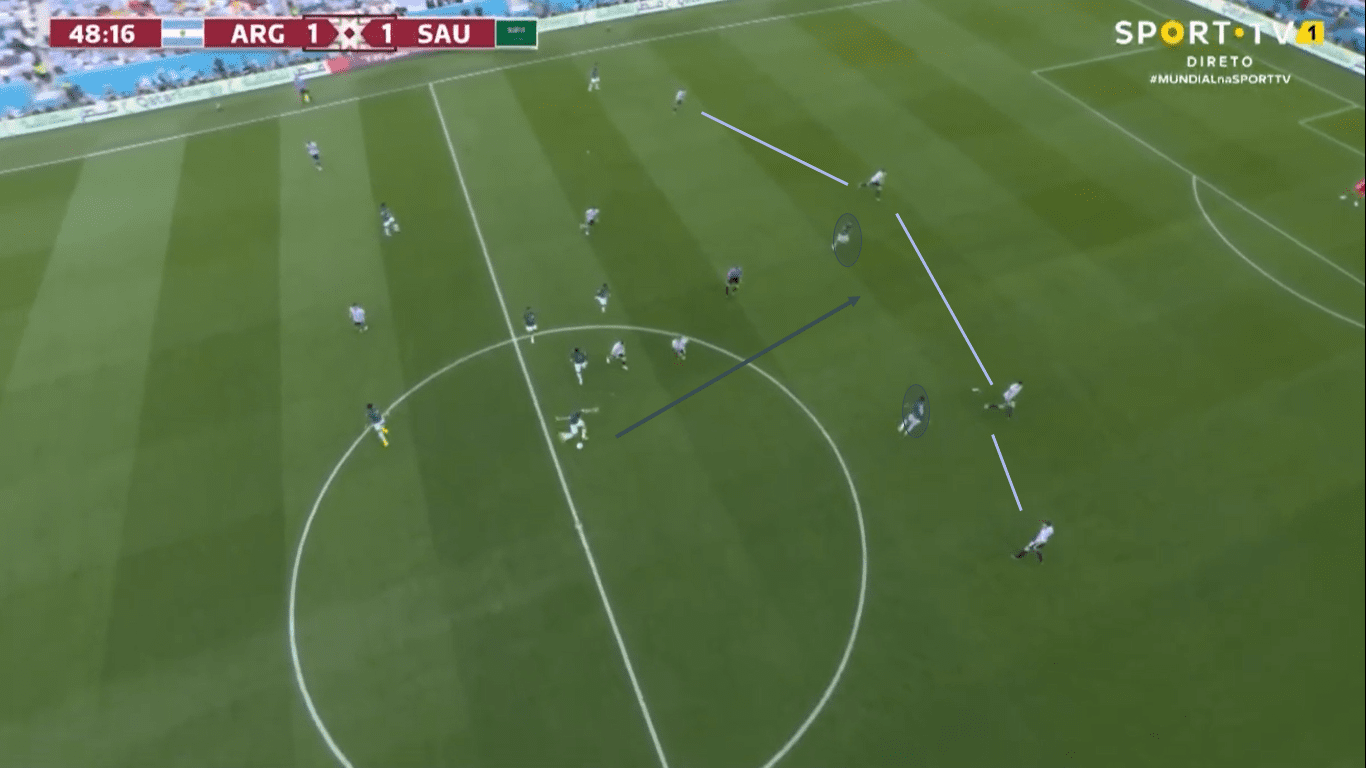
Argentina’s defensive chain has not only moved wide and lost connection with their own midfield, but is also very wide.
Saudi Arabia were able to win the ball in 2v1s against Messi and immediately afterwards, the opportunity to serve the strikers deep opened up. Argentina’s two centre-backs drop too deep and the striker runs into the attack facing the goal.
Saudi Arabia kept trying to tie up Argentina in such midfield situations to win the balls there. Due to the high conquest point, the way was then not far into the opponent’s third.
Conclusion
Finally, we will summarise the most important tactical points that have just been analysed:
Saudi Arabia were able to convince through their aggressive and compact defensive behaviour, especially in the second half, and repeatedly posed problems for Argentina. Nevertheless, the Argentines kept creating chances but were unable to take advantage of them.
Argentina could not fully involve their attacking superstars in the game. This was also due to the fact that Saudi Arabia focused on a closed centre. Opportunities for Argentina were mostly created by an advanced defensive chain.
The South Americans were rarely able to combine through the centre. This was not only due to their opponents’ compact defence but also because of their own midfielders in the build-up play.
When it became dangerous for the Saudi Arabian defence, the Argentinians resorted to making long passes behind the defensive chain. However, the attacks were not coordinated enough and they were often offside, resulting in three offside goals.
In the end, Argentina could still have won the game because of their individual class. They could have been even more dangerous in front of the opponent’s goal by opening up the game differently or playing in the spaces mentioned above.

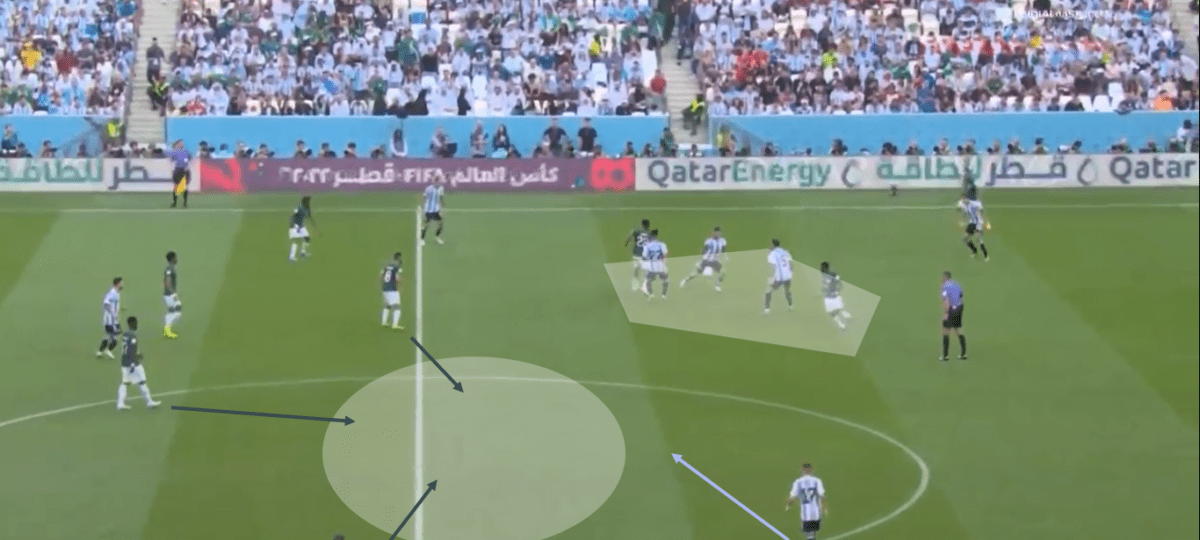



Comments